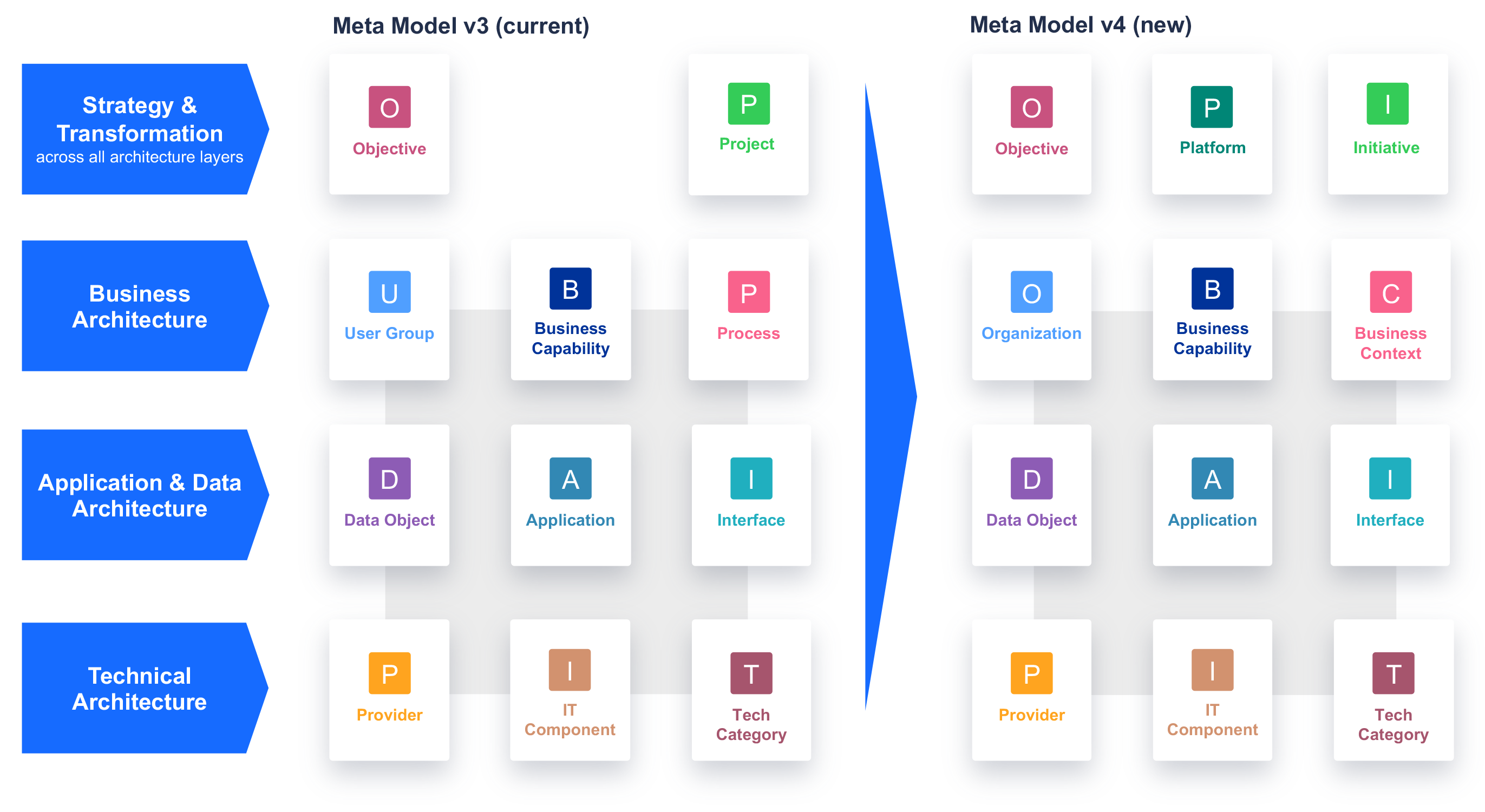Delta to Meta Model v3
This page is only relevant for existing customers of SAP LeanIX who have been working with the previous Meta Model v3 to learn about the key changes and how to apply the Meta Model v4. Please refer to the Modeling Guidelines of the Meta Model v4 for more information on each Fact Sheet type.
SAP LeanIX has updated its Meta Model v3 and is rolling out the evolved Meta Model v4 to workspaces for new customers. Existing customers using the Meta Model v3 are not obliged to change it but can decide proactively to use the Meta Model v4. This page provides detailed information on the rationale, answers frequently asked questions, and gives an overview of the delta between the evolved and the Meta Model v3.
Quick links
Configuration basic guides:
- Meta Model configuration basics (e.g., how to create fields and relations)
- To learn how to create a new fact sheet type, see Creating a Custom Fact Sheet Type.
- How to create a Fact Sheet subtype
Why has SAP LeanIX changed its Meta Model?
The evolvement of our Meta Model was a natural task for us to accommodate with trends at the interface of business and IT that has become a reality for most of our customers, and for which our Meta Model v3 did not provide the best answers and guidance. The key drivers are:
- The shift from Project to Product / Co-Existence of Product and Project
- Implementation of strategic Digital and Technical Platforms
- Reflection of references to business architecture artifacts (e.g., Value Streams)
- Modeling of Microservices & Deployments
- Classification of Organizational Usage, types of IT Components or Interfaces
We recommend that existing customers adopt the Meta Model v4 if they start new initiatives, e.g., modeling of Business Products. SAP LeanIX has guidelines for that.
What is the delta between the Meta Model v4 and the Meta Model v3?
The critical difference is the newly added Platform Fact Sheet type. In addition, some Fact Sheet types have been renamed, and we added subtypes for some Fact Sheet types. You can find all the changes in the table below.

| Fact Sheet Type | Layer | Changes |
|---|---|---|
| Platform | 1. Strategy & Transformation | New Fact Sheet type |
| Objective | 1. Strategy & Transformation | No changes |
| Initiative | 1. Strategy & Transformation | Renamed from Project Added subtypes: Idea, Program, Project, Epic |
| Business Capability | 2. Business Architecture | Maturity section with Maturity and Strategic Importance fields is now a default section in the Information section of the Fact Sheet type (previously available as a custom field) |
| Organization | 2. Business Architecture | Renamed from User Group Added subtypes: Business Unit, Customer, Region, Legal Entity, Team |
| Business Context | 2. Business Architecture | Renamed from Process Added subtypes: Business Product, Customer Journey, Process, Value Stream, ESG Capability (optional feature) |
| Application | 3. Application & Data Architecture | Added subtypes: Business Application, Deployment, Microservice (optional) Portfolio Strategy section with Gartner® TIME Framework and 6R Framework Classification fields is now a default section in the Fact Sheet type (previously available as a custom field) |
| Data Object | 3. Application & Data Architecture | No changes |
| Interface | 3. Application & Data Architecture | Added subtypes: Logical Interface, API |
| Tech Category | 4. Technical architecture | No changes |
| IT Component | 4. Technical architecture | Added further subtypes: IaaS, PaaS, SaaS |
| Provider | 4. Technical architecture | No changes |
Q&A on detailed changes
Q: Why do we need to add a Platform Fact Sheet?
A: We added a Platform Fact Sheet because we understand that management does not think in business capabilities or applications but rather in platforms. This provides an easy way to digest Information Technology. CIOs need insight into the technologies, interfaces, and applications that support their platforms.
Example: CIO.com may publish an article about how a company adopts Salesforce.com as a strategic platform - in SAP LeanIX, we should reflect that language and give insight into the technologies, interfaces, etc., support the platform
We believe that leveraging Platforms will help EAs make a more significant business impact.
Q: Why do we need to introduce a singular Business Context Fact Sheet with various subtypes?
A: We want our Meta Model to be streamlined and easily explainable on one slide. We acknowledge that Processes, Value Streams, Business Products, and ESG Capabilities are all relevant. Introducing a single Business Context Fact Sheet with subtypes allows us to cover those topics without cluttering the Meta Model.
Q: Why do we introduce default recommendations for Deployment & Microservices?
A: We believe that for advanced EA practices, it is crucial to have a straightforward way to include a layer beyond the logical application. We are introducing the Deployment and Microservice subtypes for the Application Fact Sheet to provide structured modeling standards and an appropriate licensing model for our customers who need visibility into Microservices and Application deployments in SAP LeanIX. The API subtype for the Interface Fact Sheet enables customers to model data flows between Microservices. We will provide this as an optional extension - carefully assess whether your environment (e.g., ServiceNow integration with the usage of Application Services) requires this.
Q: Why do we extend the subtypes for IT Components?
A: The IT Component Fact Sheet will now include additional ‘SaaS’, ‘IaaS', and 'PaaS’ subtypes to provide a more differentiated view of the different IT components.
Updated about 1 month ago
